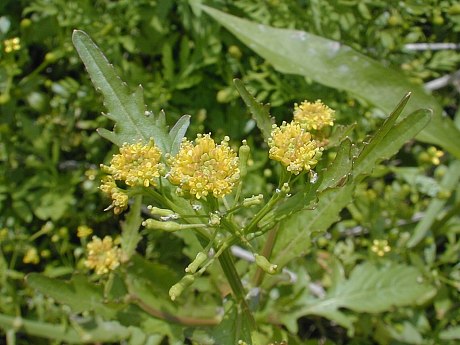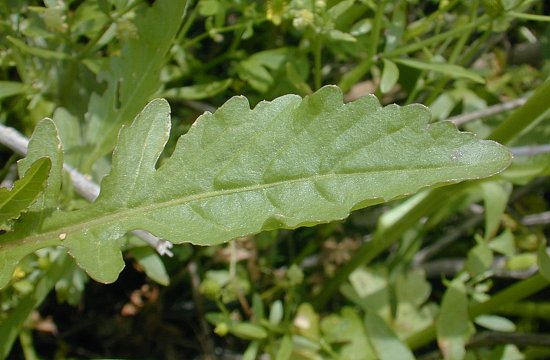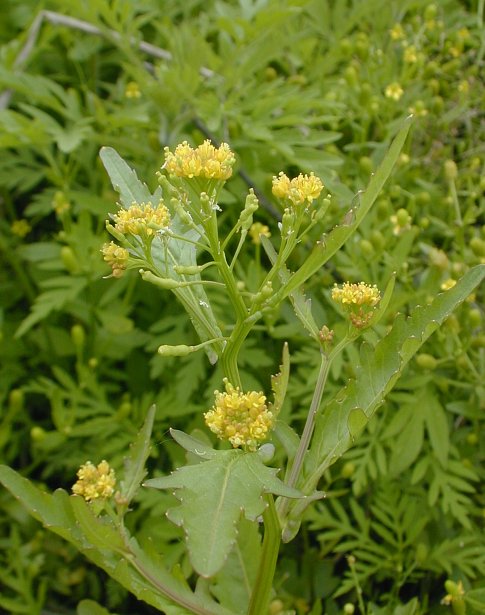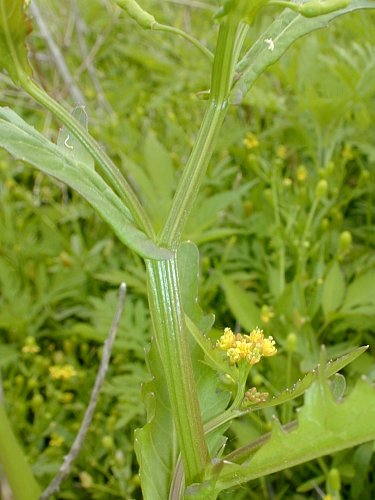Description: This biennial or annual plant is 1-3' tall; it is normally erect and branches occasionally to frequently. The stems are light green to reddish green, glabrous, and strongly furrowed or ribbed. The alternate leaves are up to 7" long, 2" across, becoming smaller as they ascend the rather zigzag stems. The variable leaves are oblanceolate or oblong-ovate, hairless, pinnately lobed (usually), and dentate or crenate along the margins. Often, there are 1-2 pairs of moderately deep lobes near the base of each leaf, and shallow lobes or large teeth elsewhere. The lower leaves have stout petioles, while the upper leaves are usually sessile, or nearly so. The leaf tips are variable in shape, ranging from blunt to acute.

The upper stems terminate in racemes of flowers about 2-8" long; more than one raceme may develop from a single stem. The small flowers bloom at the apex of each raceme, while the siliques (cylindrical seedpods) develop below. Each flower is about 3 mm. (1/8") across, consisting of 4 yellow petals, 4 greenish yellow sepals, several stamens with yellow or light brown anthers, and a pistil with a stout style. The blooming period usually occurs during the summer and lasts about 2 months. The siliques are 6-8 mm. (0.24-0.32") long, hairless, and slightly knobby; their shape is short and cylindrical (rather like little sausages, except they're green). They have neither stipes nor beaks. The slender pedicels are light green, terete, and up to ½" long. Relative to the central axis of the raceme, the siliques and their pedicels are ascending to widely spreading. Within each silique, there are two rows of small seeds. The root system consists of a taproot that is shallow and branching. This plant spreads by reseeding itself.

Cultivation:
The
preference is full or partial sun, wet to moist conditions, and a soil
containing loam, clay, and/or silt. This plant flourishes in areas that
are muddy or prone to occasional flooding. It is rather weedy.
Range & Habitat:
Marsh
Yellow Cress is a common plant that occurs throughout Illinois (see Distribution
Map).
It is native to both North America and Eurasia; some local populations
may be adventive from Eurasia. Habitats include muddy borders of ponds
and small rivers, marshes, openings in floodplain woodlands, prairie
swales, sloughs through meadows, poorly drained fallow fields, and
ditches. This plant prefers flood-prone areas that have a history of
disturbance.

Faunal
Associations:
The flowers attract small Halictid bees, Syrphid flies, and other kinds
of flies. The bees suck nectar and collect pollen, while the flies suck
nectar and feed on the pollen. Insect that feed on Marsh Yellow Cress
include Entomoscelis
americana (Red Turnip Beetle), which has been found in
Wisconsin, Minnesota, and other areas further west, and several flea
beetles: Phyllotreta
armoraciae, Phyllotreta
attenuata, Phyllotreta
bipustulata, Phyllotreta
conjuncta, Phyllotreta
striolata, and Phyllotreta
zimmermanni. Other insect feeders include Lipaphis pseudobrassicae
(False Cabbage Aphid), and such polyphagous stink bugs as Chlorochroa uhleri,
Euschistus servus,
and Holcostethus
limbolarius.
Generally, Marsh Yellow Cress is not an attractive food source to
mammalian herbivores, particularly when the foliage is mature.
Photographic Location:
A marshy area of Judge Webber Park in Urbana, Illinois.

Comments: The preceding description and distribution map apply to var. fernaldiana; this is the most common variety of Marsh Yellow Cress in Illinois. Other varieties of this species are less common in the state. These include var. palustris, which has more deeply lobed leaves than var. fernaldiana, and var. hispida, which has hairy stems and leaves. Because of its variability, Marsh Yellow Cress has been subjected to various taxonomic changes through the years, and it is occasionally referred to as Rorippa islandica. Other common Rorippa spp. (Yellow Cresses) within the state can be distinguished from Marsh Yellow Cress by the size of their flowers: Rorippa sessiflora (Sessile-Flowered Yellow Cress) is a native annual with flowers less than 1/8" across (the petals are often absent), while the Eurasian species Rorippa sinuata (Spreading Yellow Cress) and Rorippa sylvestris (Creeping Yellow Cress) have larger flowers (at least ¼" across). Sessile-Flowered Yellow Cress also has shorter pedicels (1-3 mm., or up to 1/8") than Marsh Yellow Cress. All of these species prefer disturbed wetland habitats.